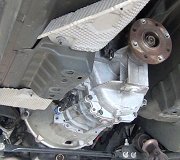No fault code refers to the battery, and fault codes never say to replace parts. They only indicate the circuit or system that needs further diagnosis, or the reason for some running problem.
If the battery really is bad you can verify that quickly with an inexpensive digital voltmeter. It should read 12.6 volts. If you find closer to 12.2 volts, the battery is good but discharged. If it has a shorted cell, the voltage will be down to around 11 volts or less, and it probably will not start the engine.
Measure the battery voltage again while the engine is running. It must be between 13.75 and 14.75 volts. When it is low, that's where the "low voltage" fault code comes from if the code is in the Engine Computer. That indicates a problem in the charging system, usually worn brushes inside the alternator. You still should have other symptoms besides shifting problems.
If that fault code was in the Transmission Computer, and the battery voltage is okay with the engine running, that indicates a problem in that computer or its wiring going to the transmission.
Be aware that a battery with a shorted cell can cause system voltage to be low with the engine running too which can be misleading. People will incorrectly diagnose it as an alternator problem when in fact, just the battery is the cause. They forget to measure the battery voltage with the engine off. If in doubt, use a small battery charger to charge the battery for at least an hour at a slow rate of around ten amps, then turn on the head lights for fifteen seconds, turn them off, then measure the battery voltage. Never charge older batteries at a high rate. That can cause them to fail sooner than normal.
Thursday, September 20th, 2018 AT 4:51 PM
(Merged)


